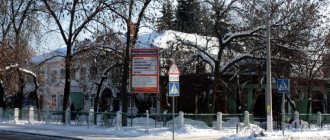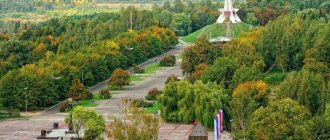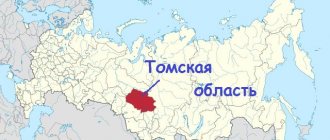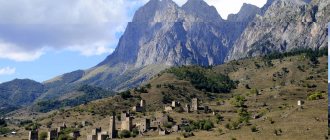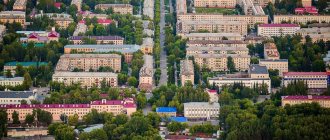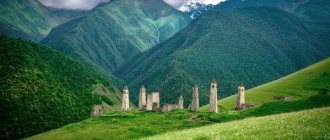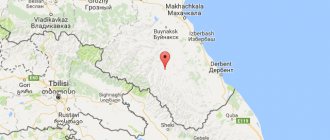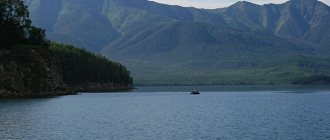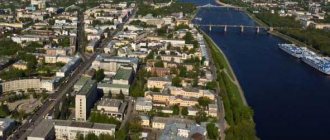| Dagestan |
Dagestan
, a republic in Russia. It is part of the North Caucasus Federal District and is part of the North Caucasus Economic Region. The capital is Makhachkala. Territory area 50.3 thousand square meters. km, population 3063.9 thousand people. (2018)
- On the map: Yandex.Map, Google map
Dagestan is located in the south of the European part of Russia, on the northeastern slope of the Greater Caucasus and in the southwest of the Caspian Lowland.
It borders: in the southeast and south - with Azerbaijan, in the southwest - with Georgia, in the west and north - with the Chechen Republic, in the northeast - with the Republic of Kalmykia, in the north - with the Stavropol Territory. The state languages are Russian and the languages of all peoples inhabiting the republic. Among them, Avar, Agul, Azerbaijani, Dargin, Kumyk, Lak, Lezgin, Nogai, Rutul, Tabasaran, Tat, Tsakhur languages have written languages and official status.
What holiday is it today?
January 22, 2022, Saturday
Today are holidays, events: Day of Unification of Ukraine Tomorrow: Premiere of the opera “Eugene Onegin” at the Bolshoi Theater
Today is the Orthodox holiday: Martyr Polyeuctus. St. Philip, Metropolitan of Moscow and All Russia, wonderworker... Tomorrow: St. Gregory, Bishop of Nyssa. Venerable Markian the presbyter. Venerable Dometian, Bishop of Melitino. St. Paul of Komel, wonderworker, student of St. Sergius of Radonezh. Saint Theophan, the Recluse of Vyshensky...
Today is a national holiday: St. Philip's Day... Tomorrow: Gregory - Summer Guide...
Seasons
Seasons, four periods of the year (spring, summer, autumn and winter) characterized by certain average temperatures. The period during which the Sun passes through one of these sectors is called the season. Spring in the Northern Hemisphere and autumn in the Southern Hemisphere begin when the Sun passes through the initial circle of declination and its right ascension is 0° (vernal equinox). Summer in the Northern Hemisphere and winter in the Southern Hemisphere occur when the sun's right ascension is 90° (summer solstice). Autumn in the Northern Hemisphere and spring in the Southern Hemisphere begin when the sun's right ascension is 180° (autumnal equinox). The beginning of winter in the Northern Hemisphere and summer in the Southern Hemisphere is considered to be the winter solstice, when the direct ascension of the Sun is 270°... Next: Seasons. Russian folk calendar. Monthly words...
Administrative division
Dagestan is divided into four territorial districts:
- Central territorial district
- Northern Territorial District
- Mountain territorial district
- Southern Territorial District
Dagestan includes 42 municipal districts and 10 urban districts
| N | Municipal district | District | Administrative center |
| 1 | Buynaksky district | Central | Buinaksk |
| 2 | Karabudakhkent district | Central | With. Karabudakhkent |
| 3 | Kayakent district | Central | With. Novokayakent |
| 4 | Kizilyurt district | Central | Kizilyurt |
| 5 | Kumtorkalinsky district | Central | With. Korkmaskala |
| 6 | Sergokalinsky district | Central | With. Sergokala |
| 7 | Babayurt district | Northern | With. Babayurt |
| 8 | Kazbekovsky district | Northern | With. Dylym |
| 9 | Kizlyarsky district | Northern | Kizlyar |
| 10 | Novolaksky district | Northern | With. Novolakskoe |
| 11 | Nogai district | Northern | With. Terekli-Mekteb |
| 12 | Tarumovsky district | Northern | With. Tarumovka |
| 13 | Khasavyurt district | Northern | Khasavyurt |
| 14 | Akushinsky district | Mountain | With. Akusha |
| 15 | Akhvakh district | Mountain | With. Karata |
| 16 | Bezhtinsky section | Mountain | With. Bežta |
| 17 | Botlikhsky district | Mountain | With. Botlikh |
| 18 | Gergebil district | Mountain | With. Gergebil |
| 19 | Gumbetovsky district | Mountain | With. Mehelta |
| 20 | Gunibsky district | Mountain | With. Gunib |
| 21 | Kulinsky district | Mountain | With. Wachi |
| 22 | Laksky district | Mountain | With. Kumukh |
| 23 | Levashinsky district | Mountain | With. Lefties |
| 24 | Tlyaratinsky district | Mountain | With. Tlyarata |
| 25 | Untsukulsky district | Mountain | With. Untsukul |
| 26 | Khunzakhsky district | Mountain | With. Khunzakh |
| 27 | Tsumadinsky district | Mountain | With. Agvali |
| 28 | Tsuntinsky district | Mountain | With. Tsunta |
| 29 | Charodinsky district | Mountain | With. Tsurib |
| 30 | Shamilsky district | Mountain | With. Hebda |
| 31 | Agulsky district | Southern | With. Tpig |
| 32 | Akhtynsky district | Southern | With. Oh you |
| 33 | Dakhadaevsky district | Southern | With. Urkarah |
| 34 | Derbent district | Southern | Derbent |
| 35 | Dokuzparinsky district | Southern | With. Shrink it |
| 36 | Kaytag district | Southern | With. Majalis |
| 37 | Kurakhsky district | Southern | With. Kurakh |
| 38 | Magaramkent district | Southern | With. Magaramkent |
| 39 | Rutulsky district | Southern | With. Rutul |
| 40 | Suleiman-Stalsky district | Southern | With. Kasumkent |
| 41 | Tabasaran district | Southern | With. Huchni |
| 42 | Khiva district | Southern | With. Khiv |
Urban districts of the Republic of Dagestan
| N | Urban district | District |
| 1 | Makhachkala city | Central |
| 2 | Buinaksk city | Central |
| 3 | Izberbash city | Central |
| 4 | Kaspiysk city | Central |
| 5 | Kizilyurt city | Central |
| 6 | Kizlyar city | Northern |
| 7 | Khasavyurt city | Northern |
| 8 | City of Yuzhno-Sukhokumsk | Northern |
| 9 | City of Dagestan Lights | Southern |
| 10 | City of Derbent | Southern |
Folk calendar about every day
Every day one season always replaces another and this determines a person’s way of life. In connection with this, a folk calendar was formed in which there were practically no nameless, unmarked days. Every day was special, had its own purpose. All this was determined by climate conditions and astrological phenomena.
A calendar is a system for counting periods of time. The first calendars arose a long time ago, in ancient times, because there was a need to measure time. The word calendar comes from the Latin words caleo - to proclaim and calendarium - debt book. This is due to the fact that in Ancient Rome the beginning of each month was especially proclaimed, and because it was customary to pay debts on the first day of the month. Different peoples counted time differently. Some calendars are based on the changing phases of the moon - lunar calendars; in others - the change of seasons - sunny; in others, the length of the year was coordinated with the change of seasons, and the counting of months was associated with the phases of the Moon. Such calendars are called lunisolar.
In Rus', the calendar was called a monthly calendar. Every day, the month book covered the entire year of peasant life, “describing” day by day, month after month, where each day had its own holidays or weekdays, customs and superstitions, traditions and rituals, natural signs and phenomena. The cyclical nature of the calendar is reminiscent of human life, where spring is youth, summer is heyday, autumn is the time of harvesting fruits (it’s good if there are some, otherwise you can live your life without collecting fruits), winter is the time of wisdom and peace. This cyclicality and rhythm determined the way of life of the farmer. The folk calendar was an agricultural calendar, which was reflected in the names of the months, folk signs, rituals and customs. Even the determination of the timing and duration of the seasons is associated with real climatic conditions. Hence the discrepancy between the names of the months in different areas... Next: Folk calendar...
Beach holidays in Dagestan
Dagestan is an excellent, although not yet very well-known, beach holiday destination for tourists from Russia. The beaches of the republic are gaining more and more admirers every year, and there are many reasons for this.
More than 200 km of beautiful coastline, with golden soft sand and shells, a comfortable climate, a long holiday season - you can sunbathe on Dagestan beaches from May to October, as well as pleasant water temperatures in the Caspian Sea - during the peak season the number on the thermometer reaches an impressive + 26…28 °C.
The resorts of Dagestan stretch from Makhachkala to the border with Azerbaijan, the most famous destinations: Makhachkala, Kaspiysk, Manas, Izberbash, Derbent.
City beach of Makhachkala
You can start getting acquainted with the resort life of the republic on the central beach of the capital. Makhachkala is a dynamically developing city, and many of the capital’s attractions, including the city beach, are quite comfortable and well-equipped.
City beach of Makhachkala
© Julia Alisova
In fact, there are several beaches in Makhachkala, and locals most often choose those that are closer to home. However, they don’t forget about the city beach, although for them it’s more of a place for walking and contemplation.
It is customary to come here all year round - fortunately, the mild climate of Makhachkala allows you to take seaside walks even in winter.
The beach is long, about 1 kilometer long, and its width is 30–40 meters. The infrastructure includes changing cabins, shower faucets, sports grounds, sun shades, and WC.
During the hot season, sea water activities are organized here. The entrance to the sea is gentle, but be careful - in some places there can be a sharp drop in depth. There are no dress code restrictions; girls in bikinis and burkinis swim nearby.
There are many tourist attractions along the beach. There is a walking Rhodope Boulevard, and children's playgrounds, cafes, attractions, kiosks with water and snacks. The embankment is beautiful and well-groomed, there are many green areas and locations for outdoor recreation.
Jami Beach
Jami Beach is considered one of the most beautiful and well-maintained beaches of the Caspian coast. No wonder - it belongs to the hotel of the same name, and entry is paid.
Ideal Jami Beach
© Hotel complex “Jami”
The money will not be spent in vain. Jami Beach has beautiful, clean sand, a convenient coastline, and modern resort infrastructure.
Even rows of sun loungers and reed umbrellas, cleaned sand, changing cabins, showers, light music - on the beach you get the feeling of relaxing in an expensive foreign hotel.
By the way, Jami Beach fully complies with all sanitary and epidemiological standards; swimming here is absolutely safe.
Guests of the complex can take advantage of numerous benefits. For example, have lunch in a cafe overlooking the sea, stroll through a well-groomed area surrounded by greenery, and admire the fountains in the evening. There are children's playgrounds for little travelers.
The location of the beach is also convenient; you can quickly get here both from the center of Makhachkala and from the local airport.
Kaspiysk city beach
The satellite city of Makhachkala, Kaspiysk, also has an excellent sandy coast. There are several beaches available to guests here, the most popular being the city beach.
Beach in Kaspiysk
© Julia Alisova
The length of the beach line is about 1 kilometer, the width is 30–40 meters.
The beach is sandy; a special feature of Kaspiysk is the abundance of shells - children will certainly enjoy this holiday.
The entrance to the sea is gentle and comfortable, the depth begins very slowly. The beaches of Kaspiysk are recommended for families with children.
There is a calm atmosphere and excellent tourist infrastructure - changing cabins, showers, rental of umbrellas and sun loungers. There is a park area nearby where you can relax in the shade and coolness during the day.
Beaches of Izberbash resort
Another great beach destination in Dagestan is to choose the Izberbash resort for your holiday.
Beaches of Izberbash resort
© Dmitry Traveler
These beaches are rightfully considered the best in the republic - they have clean soft sand, beautiful nature and a calm, relaxed atmosphere.
The city beach is long, about 3 kilometers, and approximately 200 meters wide. The sand is fine, golden, as if velvety to the touch.
Due to the length of the beach line, you can find a calm, secluded place here even during the peak holiday season.
On the beaches of Izberbash there are both “wild” areas and quite comfortable areas. Look for a relaxing holiday in comfort - you can rent umbrellas and sun loungers, cafes and snack bars, benches for contemplating the sea, and sun awnings.
Fishing calendar for every day
The fishing calendar should not be taken as an absolutely indisputable truth. Fish biting is greatly influenced by a whole range of natural factors, as well as the influence on the nature of man himself. You must not forget that the fish’s bite depends and is determined not only by the calendar dates and biological cycles of their life, reflected in the calendar, but also, no less, by the state of their habitat; the bite also depends on weather conditions: air and water temperatures, cloudiness, wind direction and strength, etc... Next: Fishing calendar...
Route No. 2: Mountain Dagestan - Gunib, Chokh and Gamsutl
On this day, it is better to wake up early - the route ahead is long. But on the way to the main tourist sites, you will find a dizzyingly beautiful road, a lot of photo stops and interesting places that are worth seeing.
Panoramas on the road to Gunib
© Julia Alisova
In the village of Gimri, pay attention to the Gimry Tower . The tower is reconstructed from the era of the Caucasian wars. The leaders of the mountaineers, imams Shamil and Ghazi-Muhammad, hid here from the tsarist troops.
You can visit the tower for free; if you go up, the observation deck offers an excellent view of the surrounding area.
Along the route you will find Saltinsky Waterfall , one of the main attractions of Dagestan. The fact is that this waterfall is unique, underground. Its water flows break through the rapids of the rocks, falling into a gloomy underground cave - a fantastic sight.
In winter, its streams freeze, turning into an icefall, and in summer, the reflections of sunbeams play on the walls. There is a dirt road leading to the village of Salta, then only on foot. During the warm season, summer cafes open along the way to the waterfall; this is one of the tourist signatures of Dagestan.
From the Saltinsky waterfall to the village of Chokh , our next stop, is about an hour's journey. Perhaps a little more - the views along the way are very picturesque!
On the way, you will pass the Gunibskaya hydroelectric station - it is not as huge and picturesque as Chirkeyskaya, but it also looks very photogenic. Pay attention to the tunnel in the mountains; in front of it there is a parking lot and a small observation deck with views of the mountains and the reservoir.
Aul Chokh
© Natalia Semchina
The village of Chokh is one of the oldest in Dagestan. Many ancient buildings have been preserved here, with a special local development - designing terraces.
The mountain on which the village is located seems to be covered with houses - very different, from picturesque ruins to beautiful stone guest houses.
If you wish, you can stay here for the night; the surroundings of Chokha are very picturesque and interesting for walks. Please note: during the season there are usually a lot of tourists here. It is better to book accommodation in advance.
A postcard view of the village opens from the observation deck near the monument to the fighter Ali Aliyev. The panorama shows Chokh against the backdrop of majestic mountains.
A few kilometers from Chokh is the famous ghost village Gamsutl . Truly mountainous and inaccessible (the last kilometers of the path can only be covered on foot), Gamsutl, thanks to its rare beauty and aura of abandonment, has become one of the most popular tourist attraction points in Dagestan.
The road to Gamsutl snakes through a dense forest. The car will have to be left at the foot of the mountain, on the river bank, and the only way forward is on foot. Ruins of houses that have preserved traces of their former beauty, abandoned streets, paths over the abyss - these days it is difficult to imagine that just a few decades ago people lived in Gamsutla.
Village of Gamsutl
© Natalia Semchina
Please note: a little before reaching the ruins of the settlement there is a rock, it is worth climbing up a narrow path (be careful) to photograph the village from that very postcard view.
Be sure to leave at least a couple of hours to visit Gamsutl. Take a walk through the quiet streets, look at the facades of houses, platbands, and porches.
300 meters before the village you will find a spring where you can refresh yourself and replenish your supply of fresh cool water.
It takes about an hour to get to the next point on the route, the village of Gunib. The road winds between valleys, majestic cliffs and apricot groves. There are many attractions in the village and its surroundings, both natural and man-made.
The Gunib fortress is interesting; it is also called the Shamil fortress, in honor of the famous freedom fighter of Dagestan. There is an observation deck nearby with excellent views of the village and surrounding mountains.
If you have any strength left, also go up to the observation deck on Mount Mayak . This is the highest accessible point in the vicinity of Gunib, its height is 2352 meters above sea level. Also known in Gunib is Tsarskaya Polyana , a historical place where Emperor Alexander I had breakfast with his officers.
If you wish, you can stay overnight in Gunib; there are both hotels and rooms in guest houses to choose from.
Orthodox calendar about every day
Orthodox calendar: Orthodox, Church and Christian holidays.
The church year is an alternation of weekdays and holidays. On weekdays, a person is called to work “by the sweat of his brow to earn his bread.” Holidays are given in order to feel liberation, to rise above the bustle and routine of the world, to feel involved in the highest of worlds, “where there are no illnesses, sorrows and sighs, but endless life.” Since ancient times, holiday cycles have been associated with the seasons. The pagans associated them with the worship of the forces of nature, the cult of which in the Old Testament was replaced by gratitude to the Creator for the universe. And although the connection between holidays and the seasons has not completely lost its power, since God is present in everything, in the plant and animal world, in human works, it nevertheless faded into the background, giving way to a spiritual foundation built on the Sacred Scriptures. The history of Orthodox holidays dates back to the times of the Old Testament. Each of the Orthodox holidays is dedicated to the remembrance of the most important events in the life of Jesus Christ and the Mother of God, as well as the memory of saints... Next: Orthodox calendar...
Russian folk calendar for every day
The word “sign” comes from the word “notice”, i.e. observe. As a result of observing what happens around a person every day, he accumulates life experience. This knowledge was passed down from generation to generation, carefully preserved and people trusted it as a sacred book. Many signs have come to us from the depths of centuries without losing their knowledge. Each of us is free to choose: to dismiss all this as an absurd superstition or to take a closer look at the signs and take the centuries-old experience of generations more seriously. Most of us, when taking exams, ask them to scold them, boasting about some kind of good fortune or luck, spit so as not to jinx them or knock on wood, take a detour if a black cat crossed the road, are afraid of the number 13 and much more. And who among us does not have lucky things, numbers? Who has never resorted to the help of fate at least once in their life, who has not believed in secrets? It’s as if everything connected with signs is hidden somewhere deep in our subconscious. Often we remember them mechanically, unconsciously, or just as a joke. But, undoubtedly, the signs contain a lot of accurate knowledge and practical wisdom of our ancestors. They cover all the characteristic, often difficult to perceive, natural phenomena. Signs have preserved a lot of what was in old folk holidays and customs; they help predict the weather, grow crops... Next: Folk signs...
Vacation with children
A family vacation in Dagestan is an excellent choice. You can come here all year round, but the summer months are the most popular - the holiday season in the republic lasts from May to October.
At this time, you are almost certainly guaranteed comfortable sunny weather - even in August the thermometer rarely shows above +30...32 °C. The water temperature is even more pleasing; in July and August the sea warms up to the point of “fresh milk” - 26...28 °C.
The largest amount of entertainment for young travelers can be found in the capital of the republic. Makhachkala is a large city with a million population; there are a huge number of parks, squares, and children's entertainment centers.
Ak-Gel Park
© WelcomeDagestan
In Makhachkala, the Ak-Gel park , located on the shore of the lake of the same name, is especially popular.
There is a monument to a Russian teacher, and nearby there is a lot of entertainment, pleasant street cafes, walking paths, attractions and a Ferris Wheel.
Be sure to take a walk along the city embankment - the beautiful Rhodope Boulevard . This is one of the oldest park areas of the Dagestan capital. There is a lot of entertainment for kids here - swings, play areas, attractions, street concerts.
A stone's throw from the Rhodope Boulevard is the entrance to the city beach of Makhachkala - you can combine a walking holiday with a sea holiday. The park is especially beautiful in the evening, when the monuments and fountains are illuminated at night.
Most likely, kids will like the Iceberg children's club , the entertainment area of the Rossiya cinema the Gorodok attractions , and the Dragon amusement park . There is entertainment for both the youngest tourists and extreme slides for teenagers.
Water park "AquaLand"
© AquaParkGo
All young travelers, without exception, will enjoy the open-air water amusement parks. Pay attention to the Luxor and Aqualand .
The Luxor water zone welcomes the whole family - there is a swimming pool, slides, attractions, a gym, a spa center and steam rooms.
The Aqualand water park is located in Kaspiysk, it’s easy to find - bright water slides and happy screams of vacationers are noticeable from afar.
The children's area is especially well thought out: bright sculptures, water slides, swimming pools, and playgrounds will not let kids of any age get bored. Teenagers will love the high-speed slides and funnels, while younger guests will love the waterfalls and fountains.
In one of the parks of Makhachkala there is a rope park "Mowgli" , and in the shopping center there is an excellent family recreation center. While relaxing in Derbent, take a walk along the city embankment, go to the zoo and circus .
When choosing the resort town of Izberbash for your vacation, pay attention to the location of the recreation center. Choose a quiet, family-friendly option, and nothing will interfere with your relaxing vacation.
Dino park in Kaspiysk
© WelcomeDagestan
In the resort town of Kaspiysk, little travelers will love the Dino Park . Here, on a large territory of 1.5 hectares, giant life-size reptiles have settled.
It’s especially funny that the sculptures can blink, move and make sounds characteristic of them.
The size of the largest dinosaur is 15 meters, the smallest is 1 meter. In total, 25 ancient reptiles “live” in the park, all of which can be touched and captured in photographs.
Children's club KINDER+KARAOKE is the first karaoke club for children in the republic. However, it will appeal not only to fans of singing; there are climbing labyrinths, children’s playgrounds, and animated entertainment programs.
Holiday calendar, dates and events of the year
All state and professional holidays in Russia, including significant World and International holidays, and other equally interesting holidays and events about every day.
The holiday has always kept pace with the history of mankind. Social time can be divided into three types: everyday life (weekdays), weekends and holidays. Everyday life is a series of practices repeated day after day and every day (work). Weekends are regular breaks from the rush of everyday life. It is believed that on weekends a person should restore his strength after working days. Day off, non-working day. A holiday is a day of celebration established in honor or in memory of someone or something. A day or series of days celebrated by the church in memory of a religious event or saint... Next: Calendar...
Prayer book, Orthodox prayers for every day
Prayer is the most powerful means for healing all illnesses - both physical and mental. Prayers can be laudatory or grateful, petitionary and repentant. If we have offended God, sinned, we must ask Him for forgiveness, that is, repent. Such prayers are called repentant prayers. If everything is fine with us, if we and our loved ones are healthy and prosperous, if we have a place to live, something to wear, something to eat, we must glorify and thank God for this. Such prayers are called praise or thanksgiving. If some misfortune, illness, trouble or need happens, you need to ask God for help. Such prayers are called petitionary... Next: Orthodox prayers...
Zodiac, astrological, eastern calendar. Zodiac signs
In ancient times, to establish the calendar, priests used knowledge of the positions of all the planets. Before the reform of Peter 1, the New Year was celebrated on the Day of the Autumn Equinox. On this day, according to ancient legend, the most peaceful treaty was concluded between the Great Race (ancient Slavs) and the Great Dragon (ancient Chinese) and it was approximately 7518 years ago... For the ancient Slavs, the calendar month corresponded to the lunar cycle from new moon to new moon, taking into account such Thus, the relationship of the entire annual cycle with astronomical and natural phenomena. There was no coherent calendar system. The main natural phenomena are still considered to this day to be the days of the solar equinox and solstice - the Slavic holidays Maslenitsa, Kupala, Ovsen and Kolyada. But during the time of Peter 1, all ancient Slavic calendars were abolished and a new Western European calendar from the Nativity of Christ (Julian calendar) was introduced, while the beginning of the calendar was moved to January 1. The Julian calendar (old style) did not take leap days into account and accumulated one extra day every 128 years. After the October Revolution in 1918, the Gregorian calendar (new style) was introduced in Russia, according to which an amendment of 13 days was introduced. The calendar of the ancient Slavs was based on two planets: the Sun and the Moon. And now they don’t use anything at all. The calendar has become static. There is no such thing as the calendar, it turns out, resting on some planet. Nobody even knows about it. There are just some standard numbers, there are months and holidays. The calendar is based on the Sun and Moon. Why is this so? Because these two luminaries influence the Earth. The Earth revolves around the Sun, and the Moon revolves around the Earth. And these two luminaries create the atmosphere on the planet. From here the calendar is built... Next: Astrological calendar...
Independent route No. 1: Getting to know Makhachkala
As a rule, no visit to the republic is complete without visiting its capital, the city of Makhachkala. This city has recently become more and more convenient, comfortable and interesting for tourists. It’s worth starting your acquaintance with the architectural calling card of the capital, the largest mosque not only in Dagestan, but throughout Russia.
Central Juma Mosque
© Julia Alisova
The Central Juma Mosque is a snow-white beauty in the center of the city. Despite its majestic appearance, the mosque is young. The first temple on this site was built in 1996, but very soon it could not accommodate everyone.
The mosque was rebuilt, including collecting donations from parishioners. Nowadays, its walls can accommodate 17,000 believers at a time.
However, visits here are allowed for representatives of all religions. Please note: men enter the mosque from the main entrance, girls - from the side. The mosque has a strict dress code; bare hair, arms and knees are not allowed.
After the sacred attraction, there is a secular one. From the mosque you can walk to Lenin Square , the administrative and cultural center of Makhachkala. Here are the Government House of the Republic of Dagestan, Friendship Square, the Imam Shamil Mosque, many cafes and an excellent, modern walking area. The Vladimir Church also attracts the attention of tourists .
According to the architects' plans, an Orthodox church and a mosque were built on both sides of the Government House. The church was opened and consecrated in May 2016; the temple was built on the memorial site of the ancient Cathedral of St. Alexander Nevsky.
A stone's throw from Lenin Square, Rasul Gamzatov Avenue . One of the central streets of Makhachkala, it is known both for architectural monuments and tourist sites, and for recreational walking areas.
Gamzatov Avenue is one of the four historical highways of Makhachkala. Back in the era of Tsarist Russia, Gamzatov Avenue was landscaped, roads were laid here, and kerosene lighting was installed.
Rasul Gamzatov Avenue
© Julia Alisova
There are many sculptures, monuments, and historical buildings on the avenue. Pay attention to the Poetry Theater, the madrasah building of the late 19th century, the National Library, the Russian Drama Theater, the Puppet Theater, and the building of the Leningrad Hotel - the first high-rise building in the republic.
Also on the avenue, guests will find nice cafe terraces, shops and shopping centers. An unusual mix of ancient architecture and modern architectural solutions is guaranteed to you.
After relaxing in one of the cafes on Gamzatov Avenue, go to the museum. Not simple, but the best in the republic - the National Museum of the Republic of Dagestan named after. A. Tahoe-Godi . Don't rush to enter, look around. The gallery's collection is kept in a monument of the era of pre-revolutionary Russia, the house of Prince Baryatinsky.
19 halls await you, with artifacts from different eras, from the Paleolithic to the modern history of the republic. The museum is open after recent restoration; all rooms are decorated with great taste.
Having enriched yourself spiritually, you can think about your body. Literally a few tens of meters from the museum is the Central City Beach. By the way, local residents visit it all year round - you can walk along the edge of the sea, warm up on the sports fields, or have a picnic in any season. In the summer there is no place for an apple to fall here - if you plan to swim and sunbathe, come early and take a comfortable place.
Near the beach there is the Rhodope Boulevard , a green walking area and the city embankment. There are all the popular tourist attractions here - swings and rides, snack kiosks, beautiful cafes, many shady areas and benches, monuments, sculptures, fountains.
Whatever season you come to Makhachkala, take a walk along Rhodope Boulevard. It looks especially picturesque in the evenings, in the glow of lights.
Pedestrian street Buynakskaya
© Julia Alisova
Another excellent walking area nearby is the pedestrian section of Buynaksky Street . It greets you with a beautiful light arch, don't miss it.
There are also several good cafes and souvenir shops here, the street will lead you to the Kumyk Musical and Drama Theater.
From here it is worth using public transport. A bus or minibus will take you to the next point of the walk, the Holy Assumption Cathedral .
Despite the Muslim spiritual status of the republic, there are also Orthodox churches in Makhachkala. The main Christian shrine of the republic is the Holy Assumption Cathedral; its history dates back to 1890. In those days it was a small wooden church; a few years later they decided to rebuild the temple in stone.
The money for the stone cathedral came from the treasury of the empire, by personal decree of Tsar Nicholas II. The consecration of the new cathedral took place in 1905, and again after the troubled times of Soviet power, in 1969. Nowadays, the cathedral operates in the status of the Cathedral Church of Makhachkala, it is open to the public every day.
Dream books online, interpretation of dreams
A dream book is nothing more than an interpreter of dreams and dreams, a translator of dreams. Since ancient times, people have been using dream books; dreams have always been given great importance, and people have often noticed the prophetic properties of some dreams. The dream book can become your faithful assistant every day and throughout your life, thanks to the dream interpreter you can always make the right decisions, the dream book will help you resist temptations in time, and will warn you against wrong steps and frivolous actions. Further…
Forecast
As for forecast data, it is quite difficult to say unambiguously today how the situation will develop. This is due to the unstable economic situation caused by the spread of coronavirus infection. But in order for the dynamics of the region’s development to be positive, numerous programs are needed that are being implemented at the state and republican levels. For example, support for young families, programs for the development of small and medium-sized businesses, improving the quality of medical care and the level of education at different levels.
